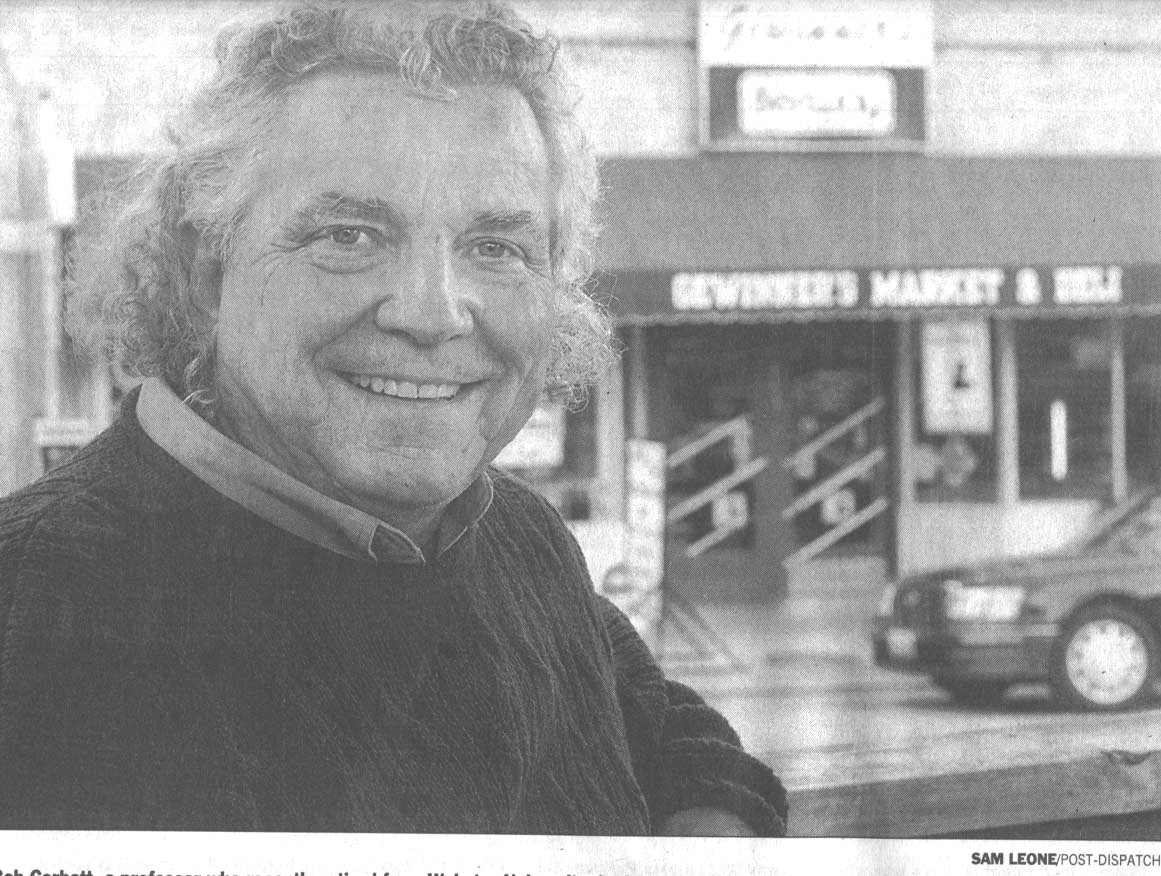

Bob Corbett, a professor who recently retired from Webster University, is doing research on Dogtown and has received information on the St. Louis neighborhood from people all over the world.
The tale of dog-eating tribespeople is "pure romanticism," says retired professor Bob Corbett.
Bob Corbett would like, first of all, to set the record straight.
The area known as Dogtown, on the western edge of St. Louis, does not owe its moniker to the Igorots, that colorful head-hunting, dog-eating Filipino tribe that was among the most popular attractions at the 1904 World's Fair.
It is utter urban legend, believes Corbett, 62, a recently retired professor of philosophy at Webster University, that the neighborhood was so named because hungry Igorots, who were living near the current site of Wydown Middle School in Clayton, came to Dogtown, the closest inhabited area, to poach pups whenever a feeding frenzy was upon them.
"Pure romanticism," he says. "Can you imagine a scantily clad aborigine prowling about undetected in a rough miner's community, looking for stray dogs? Any Igorots who ventured there alone would soon have been dead Igorots."
Dogtown - the area roughly bounded by Macklind Avenue on the east, McCausland Avenue on the west, Oakland Avenue on the north and Manchester Avenue on the south - most probably got its name instead about 1876, when St. Louis officially obtained the acreage that now makes up Forest Park.
Irish miners, who had been living close to a coal mine there, were uprooted by the city. They settled near what is now Seamus McDaniel's, a tavern at 1208 Tamm Avenue, to continue working in the area's clay mines and brick factories. Uneasy about leaving their families without protection from hoboes who wandered about the area, many of them obtained watchdogs to guard their properties - hence the name Dogtown, says Corbett.
Of course, there are still those who hold fast to the Igorot story, hotly contesting Corbett's theory. And they are more than welcome to publicly do so at www.corbettland.com, his extensive Dogtown Web site. In fact, Corbett invites such discussions eagerly, along with personal reminiscences of growing up in St. James the Greater Parish, living in the shadows of Laclede Brick Factory or dancing at The White House on Saturday nights.
Corbett grew up in Dogtown, as did his father; his grandparents moved to the area from Kerry Patch in 1915. After a 30-year hiatus in Webster Groves, he moved back in 1993 to help care for his ailing parents. In an effort to weave himself back into the fabric of the neighborhood, he began researching its roots.
"There were lots of stories and myths - none particularly accurate - circulating about Dogtown then. I started nosing around, asking lots of questions. People seemed fascinated that someone cared," says Corbett.
Before long, his scholarly bent kicked in.
"I tracked down a reputed local historian, Louis Schmidt, who had written a number of essays on the area, though he had chosen not to document his research," says Corbett. "Before he retired to Branson, I copied his computer discs and an enormous number of his papers. It was a gold mine of information."
That's when Corbett began delving into Dogtown's past in a major way, interviewing residents, tracking down pictures and finding legitimate historical sources - all while continuing his teaching career, including stints at Webster University's campus in Vienna, Austria.
"I'm a pretty compulsive person," admits Corbett. "You might say this quest took over my life."
About two years ago, he began building the Web site based on his research files. It offers essays on facets of Dogtown history from the Forest Park Highlands to the St. Patrick's Day parades; photos of almost every St. James School graduating class dating from 1904; and a continuing discussion group that now boasts 120 members from Australia to Alaska - all avid Dogtown aficionados.
And though many of them are former residents who simply want to connect with classmates from various schools (Gratiot, Roe and Dewey public elementary schools as well as St. James) or trade neighborhood gossip from Franz Park or Hi-Pointe, Corbett finds their chatter to be "highly personalized oral histories, full of fascinating nostalgia" that provides him with new avenues to research.
"My own interest is to try to excite people about Dogtown's history in a larger sense - the origins of the neighborhood, its phases and development," he says.
To that end, Corbett offers the following thumbnail sketch:
There is talk of beginning a Dogtown Historical Society, for instance, and the first meeting of Corbett's e-mail discussion group recently took place at a union hall on Tamm Avenue. Corbett has led some informal walking tours of the area; he is now compiling lists of century homes and attempting to collect bricks from the different factories that once operated in Dogtown. He has fielded inquiries about publishing a book on Dogtown but says he remains philosophically opposed to the idea.
"I don't like the idea of selling intellectual property; I prefer the free exchange of ideas on my Web site," he says. "I have other goals. Right now, I'd love to be able to distribute used computers to some of the elderly residents of Dogtown. They probably have fabulous stories to contribute."
==========================
The article was accompanied by photos.
Caption:
(1) Color photo by SAM LEONE/POST-DISPATCH - Bob Corbett, a recently retired professor from Webster University, is doing research on Dogtown and has received information on the St. Louis neighborhood from people all over the world.
(2) Color map by the Post-Dispatch - DogtownPHOTO, MAP
| HOME | DOGTOWN |
| Bibliography | Oral history | Recorded history | Photos |
| YOUR page | External links | Walking Tour |